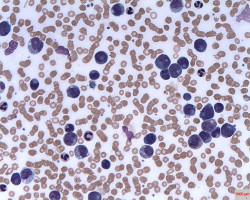
Chronic lymphocytic leukaemia (CLL) is a haematological malignancy that originates in the blood-forming cells of the bone marrow and spreads to other organs through the bloodstream.
When infiltrating tissues, CLL cells come in contact with healthy cells, including immune cells.
To ensure their survival and growth, CLL cells are able to establish a microenvironment in which the immune response is suppressed.
Researchers from the Luxembourg Institute of Health (LIH) succeeded in characterising in depth the composition of immune cells and circulating cytokines of the CLL microenvironment in mouse models using mass cytometry.
Based on this knowledge, they propose an immunotherapeutic strategy with two immune checkpoint inhibitors that efficiently blocks disease development in preclinical tests.
The scientists published their findings in open access in the April 2018 issue of the acclaimed scientific journal Blood.
CLL is a common leukaemia type that mostly affects adults above the age of 50, progresses slowly and often remains without apparent symptoms for a long time.
The disease is currently not curable, but different treatments can prolong life expectancy.
CLL can only develop in a tumour-supportive microenvironment in which the immune response is suppressed.
To better understand how this immune suppression is achieved, researchers from the Laboratory of Experimental Cancer Research at LIH's Department of Oncology aimed to characterise the profile of immune cells in the tumour microenvironment.
To analyse the composition of immune cells in the CLL microenvironment, the scientists transferred spleen cells from diseased donor mice to healthy recipient mice.
After a few weeks, the cell populations in the spleen of the recipient mice were monitored with flow and mass cytometry.
The researchers observed a significant remodelling of the numerous cell populations and cell subtypes when comparing samples from diseased mice to those of healthy controls.
The tumour microenvironment was mainly characterised by the presence of more regulatory immune cells such as Tregs that contribute to inhibiting immune responses. It was also noticed that many cell types display a high quantity of immune checkpoint molecules on their surface.
Moreover, CLL leads to an altered profile of circulating cytokines.
Based on the newly gained knowledge on the composition and features of immune cells in the tumour microenvironment, the scientists tested whether treatments with antibodies that act as inhibitors of immune checkpoints could serve as immunotherapy to reboot the anti-cancer defence.
They tested anti-PD1, anti-LAG3 and anti-KLRG1 antibodies as single as well as dual treatments in mice.
They found that the simultaneous targeting of the two immune checkpoints PD1 and LAG3 efficiently kept the number of CLL cells low in the spleen and in the bloodstream and even reduced the size of the spleen.
When spleen cells were transferred to recipient mice, the dual blockade efficiently prevented the disease to develop in these animals.
The researchers observed that the dual antibody therapy is able to restore an immunocompetent environment containing more effector and less immune-regulating cells.
"The present study represents a significant advance in the field of CLL research", state Dr Etienne Moussay and Dr Jérôme Paggetti who led the project. "It allowed to greatly expand the knowledge on the immune cell populations present in the tumour microenvironment. Most importantly, we were able to propose an effective therapeutic strategy to block tumour development which could be tested in clinical trials in the future."
Source: Luxembourg Institute of Health
The World Cancer Declaration recognises that to make major reductions in premature deaths, innovative education and training opportunities for healthcare workers in all disciplines of cancer control need to improve significantly.
ecancer plays a critical part in improving access to education for medical professionals.
Every day we help doctors, nurses, patients and their advocates to further their knowledge and improve the quality of care. Please make a donation to support our ongoing work.
Thank you for your support.